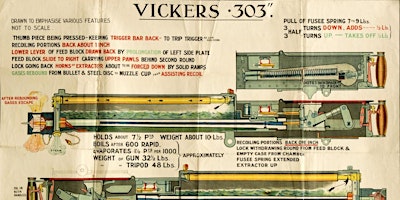The ‘commander’ of a machine gun section is not a defined role over the life of the Vickers MG. To determine that persons rank and role in the overall machine gun unit, it is necessary to identify the particular command element in British service that is being considered.
1912 – 1938
During the period of the Great War, the overall section was commanded by an officer, whilst the sub-sections were commanded by a Serjeant and a Corporal. They carried out slightly different roles as described below.
- Section Officer
The duties of the section officer are to command his section in accordance with his orders and the tactical situation; to select gun positions, to observe, and to control fire generally; to regulate the ammunition supply, and to give instructions regarding the movement of unlimbered wagons. When guns are brigaded, he acts under the instructions of the brigade machine gun officer, watches for signals, and acts as the brigade machine gun officer may direct.
In allotting the various duties, section officers should select the men who show a particular aptitude for each duty, and the next best should be those who would probably be most quickly available on service to replace a casualty. The results obtained in Table “C,” in Range Takers’ Tests, and in Tests in Belt filling, will assist section officers in detailling the numbers, and for this purpose they will keep careful record of the characteristics and particular aptitude of each man. Nos. 1, 2 and 3 should be the best in that order of merit at laying and holding, Nos. 5 and 6 at range taking, and No. 4 at belt filling. In peace, the numbers should frequently change round, so that each may be trained in the duties of all numbers under various conditions.
The serjeant should similarly be practised in the duties of section officer and the corporal in the duties of the serjeant.
- Serjeant / Sergeant
The duty of the serjeant is to supervise guns coming into action as the section officer may direct. He must be prepared to take command of the section in the event of the officer becoming a casualty.
- Corporal
The corporal is generally responsible for the packing and contents of the limbered wagon. On the line of march he marches behind it and works the brake as required. On the order to unpack he will lower the tail board, superintend the unpacking and take command in the absence of the section officer or serjeant. He will see that Nos. 4 put their own rifles as well as those of Nos. 1, 2, and 3 in the wagon. He will have the spare box handy, supervise the ammunition supply and filling of belts, direct the limbered wagon as required, superintend the filling of sandbags and cutting of brushwood, and watch for signals from the section officer. He will be prepared to take the place of the serjeant should he become a casualty.
1939 – 1942
At the start of the Second World War, there were insufficient numbers of subalterns to act as platoon commanders. The Army had mobilised much quicker than suitable men for officer positions could be training. Therefore, a new rank was created: Warrant Officer Class III. Originally established in the Regular Army by Army Order 202 of 1939, it was introduced to the Territorial Army by Army Council Instruction 732 of 1939, published on 28 October. In the Infantry of the Line, the appointment for this rank was Platoon Serjeant Major. Within a machine gun battalion, these men commanded a machine gun platoon and, therefore, substituted for the subaltern.
As soon as sufficient numbers of subalterns were available, the policy on the use of Warrant Officers, Class III, in these posts was changed. No further promotions were permitted from July 1940 (Army Council Instruction 804 of 1940) but they were to be used if available.
1943 (Airlanding)
1943 – 1968
The fighting elements of the Vickers MG Platoon in WW2 and Post WW2 had Platoon and Section Commanders. The Platoon Commander was largely one of tactical co-ordination and did not carry any MG-related specialist equipment; however, the Section Commander would have been involved in man-carrying the Vickers. In the 1951 Manual, the Section Commander is identified as carrying the following equipment on a ‘long carry’.
- Director (in case).
- Stand, director.
- 88 set.
- 2 liners – SAA*.
- 1 pr binoculars.
- 1 pr wire cutters.
Sources
- The National Archives, WO 293/24 Army Council Instructions 1939.
- The National Archives, WO 293/25 Army Council Instructions 1940.
- War Office, 1912
- War Office, 1951b.








